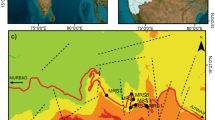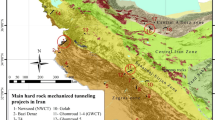Abstract
The geological environment of underground engineering is complex and full of various uncertainties, and ensuring the reliability of tunnel surrounding rock rating results is crucial for projects. In this study, we first analyze the interrelationships and indicator weights of international mainstream rating methods of tunnel surrounding rock, and summarize the applicability of each method. Next, based on dialectical materialism, we propose that the uncertainties can be divided into multiple levels. Then we analyze the probability distribution law of rating indicators such as rock strength and rock integrity, introduce and use the theory of system reliability analysis, and build functions for the surrounding rocks of different classes. Finally we calculate the reliability probability of surrounding rock rating using Monte Carlo method. The study results indicate that, in view of the uncertainty of surrounding rock rating, the proposed approach fully considers the information of each rating method, and also the data dispersion of local fractured zones, weak interlayers and other tunnel face surrounding rock. Moreover, based on the parameters summary, the proposed approach is proved to be applicable to the current rock mass, and thus makes it possible to evaluate the reliability probability of the tunnel surrounding rock rating. This study helps site personnel to assess surrounding rock rating results more conveniently and accurately, and provides precise guidance for reasonably determining the construction method transition interval and optimizing support parameters.
Similar content being viewed by others
References
Abad J, Celada B, Chacon E, et al (1983) Application of geomechanical classification to predict the convergence of coal mine galleries and to design their supports. In:5th ISRM Congress. Melbourne, Australia, pp 1–5. https://doi.org/10.1016/0148-9062(84)92847-X
Al-Harthi AA (1993) Application of CSIR and NGI classification systems along tunnel No. 3 at Al-Dela descent, Asir Province, Saudi Arabia,Cripps JC. Coulthard JM, Culshaw MG, et al. (eds.) The Engineering Geology of Weak Rock
Barton N (1995) The influence of joint properties in modelling jointed rock masses. In:8th ISRM Congress. Tokyo, Japan, pp 25–29
Barton N, Lien R, Lunde J (1974) Engineering classification of rock masses for the design of tunnel support. 8F 14T 24R Rock mechanics, v6, n4 6 (4):189–236. https://doi.org/10.1016/0148-9062(75)91319-4
Bieniawski ZT (1973) Engineering classification of jointed rock mass. Trans.S.Africa Inst, CivEngrs, 15(12):352–356.
Bieniawski ZT (1976) Rock mass classification in rock engineering applications. In:Proceedings of a Symposium on Exploration for Rock Engineering. Cape Town, Balkema, pp 97–106
Cai B, Yu Y, Wu XM (2001) The relationship between the “Engineering Rock Mass Classification Standard” and the Q classification method and RMR classification. Journal of Rock Mechanics and Engineering, 20(S):1677–1679. (in Chinese)
Cameron-Clarke IS, Budavari S (1981) Correlation of rock mass classification parameters obtained from borecore and in-situ observations. Eng Geol, 17(1–2):19–53, https://doi.org/10.1016/0013-7952(81)90019-3
Cao JH (2006) An introduction to mathematics of reliability. Beijing: Higher Education Press. (in Chinese)
Chu HD, Xu GL, Li PP, Zhu KJ, Wu GZ (2013) Correlation analysis and application of surrounding rock classification in large underground caverns. Engineering Geology 21(5):688–695. (in Chinese)
Franklin JA, Pells P, Mclachlin D, et al (1986) Translated by XIANG Gui-fu. International society for rock mechanics experimental methods committee the suggested method of determination of point load strength. Chinese Journal of Rock Mechanics and Engineering, 5(1): 79–90.(in Chinese)
Guo ML (2003) Discussion on adaptability of point load test of rocks. Rock and Soil Mechanics, 24(3): 488–494. (in Chinese)
Hassani FP. Application of the point load index test to strength determination of rock and proposals for a new size-correction chart[C]//21st Symp. on Rock Mechanics
Kaiser TK, Gale AD (1985) Assessment of cost and emprical support design at BC Rail Tumbler Ridge tunnels. Wiley, New York, pp 77–106
Karzulovic A, Goodman RE (1985) Determination of principle joint frequencies. International Journal of Rock Mechanics and Mining Sciences and Geomechanics Abstracts, 22(6): 471–473.
Kulatilake P, Wu TH (1984) The density of discontinuity traces in sampling windows. International Journal of Rock Mechanics and Mining Sciences and Geomechanics Abstracts, 21(6): 345–347.
Kumar N, Samadhiya NK, Anbalagan R (2004) Application of rock mass classification systems for tunneling in Himalaya, India. Int J Rock Mech Min, 41:852–857, https://doi.org/10.1016/j.ijrmms.2004.03.147
Li PF, Zhang ZY, Tao LJ (2003) Research on rock mass quality classification of underground powerhouse of a hydropower station in southwest China. Hydropower Station Design, 2:71–73. (in Chinese)
Liu JK, Jiang YJ, Sakaguchi O (2021) Optimized ANN model for predicting rock mass quality ahead of tunnel face using measure-while-drilling data. B Eng Geol Environ, 80(3):2283–2305, https://doi.org/10.1007/s10064-020-02057-6
Lu SQ (2004) Rock mass quality classification and control on surrounding rockmass stability of the Underground Cavities of Nuozadu Hydro-electric Project. Dissertation, Chengdu University of Technology. (in Chinese)
M. Zhang (2009) Structural reliability analysis - methods and procedures. Beijing, China
Moreno TE (1980) Application de las c1assificaciones geomechnicas a los tuneles de parjares. In:11st Cursode Sostenimientos Activosen Galeriasy Tunnels. Found Gomez Parto, Madrid, Spain.
Qu HZ, Yao PC (2017) Correlation and application of common classification methods for surrounding rock of caverns. Journal of Underground Space and Engineering, 13(S2):732–735, (in Chinese)
Rutledge JC, Preston RL (1978) New Zealand experience with engineering classifications of rock for the prediction of tunnel support. In:Proceedings of the International Tunnelling Symposium. Tokyo, Japan, A31–A37
Sadeghi S, Sharifi Teshnizi E, Ghoreishi B (2020) Correlations between various rock mass classification / characterization systems for the Zagros tunnel-W Iran. J Mt Sci-Engl, 17(7)1790–1806, https://doi.org/10.1007/s11629-019-5665-7
Sayeed I, Khanna R (2015) Empirical correlation between RMR and Q systems of rock mass classification derived from Lesser Himalayan and Central. In:International Conference on “Engineering Geology in New Millennium”. New Delhi, India, pp1–12
Senra K (2016) Correlations between geomechanical properties to amphibolites and schists from south of Minas Gerais state, Brazil, Master of Science Thesis in Civil Engineering, Universidade Federal de Viçosa, Brazil.
Shao JL, Gao L, Wu QH, Gu XB (2022) The Application of Variable Fuzzy Sets Theory on the Quality Assessment of Surrounding Rocks. Adv Mater SCI Eng, 2022, https://doi.org/10.1155/2022/5441829
Shen YJ, Xu GL, Zhang YF, Zhu KJ (2010) Application of extenics theory to rock quality underground cavern based on set pair analysis. Geological Science and Technology Information, 29(5):125–130.(in Chinese)
Su YH (2007) Construction method of fuzzy membership function of geotechnical parameters and its application. Chinese Journal of Geotechnical Engineering, 29(12):1772–1779.(in Chinese)
The National Standard Compilation Group of The People’s Republic of China. GB 50287-1999 The Code for engineering geological investigation of water resources and hydropower[S]. Beijing: China Planning Press, 2014. (in Chinese)
The National Standards Compilation Group of People’s Republic of China. GB50218-94 The Standard for engineering classification of rock masses. Beijing: China Planning Press, 1995. (in Chinese)
Tugrul A (1998) The application of rock mass classification systems to underground excavation in weak limestone. Ataturk dam Turkey. Eng Geol, 50(3–4)337–345, https://doi.org/10.1016/S0013-7952(98)00034-9
Wang GD (2006) A study on surrounding rock classification under complex conditions - taking the surrounding rock classification of deep buried tunnel of Jinping II Hydropower Station as an Example. Dissertation, Chengdu University of Technology.(in Chinese)
Wang JC, Guo J (2019) Research on Rock Mass Quality Classification Based on An Improved Rough Set-Cloud Model. IEEE ACCESS 7:123710–123724. https://doi.org/10.1109/ACCESS.2019.2938567
Wang M, Shi YC (2010) Selection of rock mass quality grading methods for a soft rock underground powerhouse. Guizhou Hydroelectric Power Generation, 24(5):20–24. (in Chinese)
Wang MW, Li L, Jin JL (2008) Set pair analysis-variable fuzzy set model for evaluation of stability of surrounding rock. Chinese Journal of Geotechnical Engineering 30(6): 941–944.(in Chinese)
Wang R, Tang CA, Wang SH (2008) Study on several problems about point load test of rock. Journal of North Eastern University (Natural Science), 29(1): 130–133. (in Chinese)
Wang WG, Wang ML (1988) Errors and correlative analysis in point load tests. Chinese Journal of Rock Mechanics and Engineering, 7(4): 309–319. (in Chinese)
Wei XC, Liu SD, Xiao HB, Wang G (2019) Study on the classification of surrounding rock in the underground powerhouse of Linggu Hydropower Station. Modern Tunnelling Technology, 56(1):22–26, https://doi.org/10.13807/j.cnki.mtt.2019.01.004(in Chinese)
Wei YJ (2007) Research on the structural characteristics and engineering application of Emeishan Basalt rock mass in the Southwest Hydroelectric. Dissertation, Chengdu University of Technology (in Chinese)
Wu AQ, Liu FZ (2012) Advancement and application of the standard of engineering classification rock masses. Chinese Journal of Rock Mechanics and Engineering, 31(8):1513–1523. (in Chinese)
Wu AQ, Zhao W, Zhang YH, Fu X (2023) A detailed study of the CHN-BQ rock mass classification method and its correlations with RMR and Q system and Hoek-Brown criterion. Int J Rock Mech Min, 162, https://doi.org/10.1016/j.ijrmms.2022.105290
Wu LX, Liu DX, Cao P (2020) Rock Mass Quality Evaluation Based on Unascertained Measure and Intuitionistic Fuzzy Sets. Complexity, 2020. https://doi.org/10.1155/2020/5614581
Wu Q, Kulatilake P, Tang HM (2011) Comparison of rock discontinuity mean trace length and density estimation methods using discontinuity data from an outcrop in Wenchuan area, China[J]. Computers and Geotechnics, 38: 258–268.
Xiao YH (2009) Nonllinear systemic study on the stability of surrounding rock of Shuangfeng Freeway Tunnel. Dissertation, Jilin University (in Chinese)
Xiao YH (2009) Nonllinear systemic study on the stability of surrounding rock of Shuangfeng Freeway Tunnel. Dissertation, Jilin University. (in Chinese)
Xu T, Zhang DL, Li A, Fang Q, Yu L, Li R (2021) Dissecting the robustness of the rock mass classification methods used in Jiaozhou Bay Subsea Tunnel. Int J Civ Eng, 19(12):1473–1482, https://doi.org/10.1007/s40999-021-00625-9
Yan TJ, Wu XT, Wu L (2009) Correlation study and engineering application of surrounding rock classification in underground caverns. Journal of Underground Space and Engineering 5(6):1103–1109. (in Chinese)
Yang JH, Guo WX, Qi SH, Zhang DL (2014) Research on classification method for surrounding rock of underground powerhouse of CCS Hydropower Station. Tunnel Construction, 34(7):623–628. (in Chinese)
You K (1992) Infill sampling design for tunnel rock classification using both quantitative and qualitative information. Dissertation, University of Minnesota
Yuan HP, Chen CH, Wang YX, Bian HB, Liu Y (2020) Joint investigation and 3D visual assessment of rock mass quality. Adv Civ Eng, 2020, https://doi.org/10.1155/2020/8858322
Zhang GF, Liu ZS, Chen XK. et al (2014) Reliability analysis of measuring strongly weathered grey mudstone strength with point load measurement. Rock and Soil Mechanics, 2014, 35(Supp.1): 293–297.(in Chinese)
Zhang YF, Cheng CG, Zhang HF, Li J, Hou HW (2008) Interval numbers-based integrated classification method for surrounding rock of highway tunnel 30(12):1915–1920. (in Chinese)
Zhang ZY, Tao LJ, Li PF, et al (2015) Stability analysis and assessment of surrounding rock of large underground caverns. Beijing, China(in Chinese)
Zhou ZD, Hu XW (1999) Discussion on the selection of rock mass quality classification of a hydroelectric power station abutmenta. Journal of Chengdu University of Technology, 26(1):82–85. (in Chinese)
Acknowledgements
This work was supported by the National Natural Science Foundation of China [Grant No. 52079077] and China Postdoctoral Science Foundation (Grant No. 2022M711962)
Author information
Authors and Affiliations
Contributions
Feng Jiang contributed to conception and design of the study. Feng Jiang, Peng He, Sichen Feng,Gang Wang, Zhiyong Xiao, Yan Chen and Chengcheng Zheng organised the database. Peng He, Sichen Feng and Feng Jiang performed the statistical analysis. Peng He, Sichen Feng and Feng Jiang wrote the first draft of the manuscript. Feng Jiang,Gang Wang and Yan Chen wrote sections of the manuscript. All authors contributed to manuscript revision, read, and approved the submitted version.
Corresponding author
Additional information
This work was supported by the National Natural Science Foundation of China [Grant No. 52079077] and China Postdoctoral Science Foundation (Grant No. 2022M711962)
Peng He (1988–), male, from Laiwu, Shandong Province, PhD, Associate Professor, mainly engaged in stability analysis, dynamic evaluation and control research of tunnel rock mass structure. E-mail: hepenghank@163.com.
Sichen Feng (1997-),female, from Cangzhou, Hebei Province, M.Sc. student, mainly Research on tunnel mechanics and underground engineering disaster prevention and control. E mail: 1558610035@qq.com
Feng Jiang (1995–), male, from Jining, Shandong Province, PhD student, mainly Research on deep rock mechanics and underground engineering disaster prevention and control. E mail: jfnjzy@163.com
Rights and permissions
About this article
Cite this article
He, P., Feng, Sc., Jiang, F. et al. An approach to analyzing the reliability of tunnel surrounding rock rating results considering uncertainty. Appl. Geophys. 20, 642–667 (2023). https://doi.org/10.1007/s11770-023-1047-6
Received:
Revised:
Published:
Issue Date:
DOI: https://doi.org/10.1007/s11770-023-1047-6




